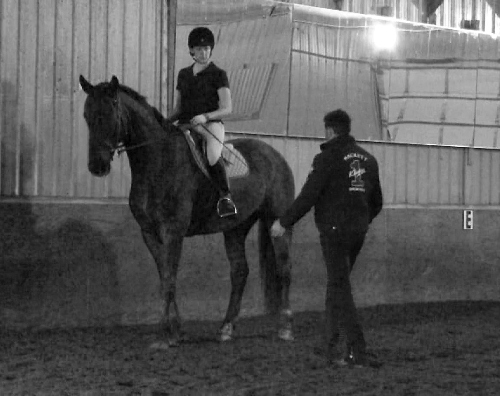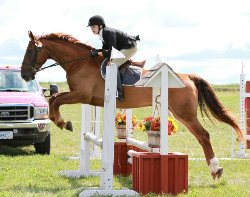Clinic: David DeWispelaere
I intended to do a blog post about this clinic right after I rode in it – but time got away, and away, and away. Here, instead, is an article I wrote about it for the latest edition of Cross Country Magazine.
David DeWispelaere is a Grand Prix rider and trainer known for his use of classical dressage methods, emphasizing lightness and harmony in the communication between a horse and rider. He regularly conducts clinics throughout the United States and Europe. This April, he spent three days teaching at several farms in the west metro.
I rode my 6-year-old gelding Poe in one of David’s sessions, and audited several others. What stuck with me the most about David’s approach was his softness, patience, and calm attention to each horse’s emotional state. Before my ride, I caught part of a session with a young, sensitive mare. David had her rider go with a longer rein on a 20-meter circle, encouraging the mare to find her own balance while soothing her nerves with this simple exercise. In very little time the mare relaxed and stretched down, going in an even rhythm. Once she was calm, David had her rider “try to get a little closer to her” by shortening the reins slightly. The mare stayed even, round, and comfortable, and the pair were able to go on to cantering around in the same calm attitude – a nice accomplishment given the mare’s history and greenness.
I’m an adult amateur event rider with a young horse whose attention span and interest in dressage is still a work in progress. I’m currently trying to teach him to carry himself like a horse instead of a giraffe, so my work with David was largely focused on encouraging Poe to relax and seek contact.
David began our lesson by asking about our background, then had us show him how we typically warm up. Once we were ready, he put us on a 20-meter circle with a long rein, then asked that we gradually spiral in to a smaller circle, always encouraging Poe to stretch into a long contact. David emphasized that when the horse is going well, we should leave them alone: “That’s when he should go the best – when you do nothing, when you leave him alone when he finds the right way.”
I was impressed by David’s use of simple instructions and movements to educate both the horse and the rider. On the smaller circle, he asked me to reach forward to touch Poe’s neck with my inside hand. It revealed instantly when my outside aids were effective and when they weren’t. Without a good connection in the outside rein and Poe’s respect and understanding of my outside leg, giving away the inside rein would make the circle bigger. This is a concept I’ve read and heard a thousand times – a simple, classic exercise – but something in the way David showed me created a lightbulb moment. His awareness of how this exercise guided my horse’s attention and attitude was key – it taught me something new about the purpose of the pattern, rather than just its mechanics.
Throughout the lesson we used simple tools – enlarging and decreasing the circle, serpentines – to try to show Poe that he’s responsible for his own balance. (I love my horse’s big head, but I am NOT interested in holding it up for him!) “If he loses his way,” David said, “show him the right way again. Then give him more freedom. We want him to go round because he reaches for the contact, not because you have to hold him there. It should feel natural for him to go round.” It’s been hard to kick the instinct to try to “help” my horse by shortening the reins and asking more loudly, but ultimately it should make him into a more thinking, willing partner.
Probably my greatest take-away from this clinic is the value of patience. Though there were plenty of appearances of Poe’s giraffe impression, when I continued to ride the patterns calmly, patiently, and correctly, he eventually figured out that it’s easier and more comfortable to stretch down. He started to take more responsibility for his own way of going, and tune into what I was asking him. David and I also discussed other tools for getting Poe’s attention, including changes of gait, backing, and in-hand work.
I enjoyed David’s soft, thoughtful approach to each horse he worked with, and his emphasis on trust and communication. For more information on David, visit http://www.dwdewispelaere.com.

